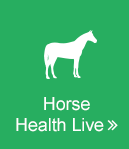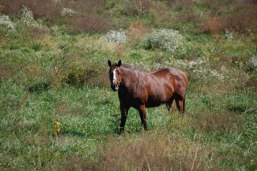Horses are large, powerful animals that often amaze us with their feats of strength and stamina. Sometimes it is easy to forget how fragile they can be. Their unique digest tract in particular can be disrupted by a variety of factors that can lead to a very serious condition known as colic. Colic is a general term that means abdominal pain, and there are many different causes and types.
Biology of Colic
Horses evolved to graze throughout the day, eating many small meals. They have a relatively small stomach and the valve between their esophagus and their stomach has a one-way action that allows food, fluid and gas in, but not out. That means that horses cannot vomit or belch. If digestive upset causes material to have difficulty passing from the stomach into the small intestine, the horse is at risk of their stomach rupturing since nothing can move up the other way. Horses also have very long intestine – over 65 feet long! – and an organ called a cecum off of their intestine. This large pocket acts as a storage area where ingested food can ferment and be broken down by good bacteria. During the normal digestion process, bacteria break down roughage and produce gases, liquids and gentle gurgling sounds. Toward the end of the digestive tract the colon has an area where the diameter decreases and the colon folds back on itself called the pelvic flexure. All of these long pieces of intestine, pockets, bends, changes in diameter, and mesenteric membrane that connects the intestine put the horse at risk of having food or gas becoming lodged in different areas or getting twisted. Additionally, there are only 2 main arteries that feed blood to the intestines so if they are squeezed or twisted, blood supply can be restricted very quickly.
Types of Colic
The most common type of colic is Gas or Spasmodic Colic where excessive gas build-up stretches the intestinal wall, which is very painful for the horse. When your horse experiences this type of colic they will be very restless, anxious and often sweat or try to roll because they experiencing intestinal spasms. Their gut makes a lot of loud noises and you can tell they are in pain.
A build-up of fluid or food can have the same painful effect. A build up food that gets stuck is called Impaction Colic. Horses tend to become impacted if they are not drinking enough water to hydrate their food and keep it moving through the gastro-intestinal tract. Impactions can also result from a heavy parasite load, ingestion of sand or stones in the GI-tract. Even tumors can block the GI tract and cause colic-symptoms. Impaction Colic is recognized because the horse cannot produce manure, does not want to eat and wants to lay down. As the condition gets worse, their mucus membranes get dark and their temperature drops. The vet can identify it because the colon is usually impacted. Impaction Colic can turn into Strangulation Colic if any part of the gastro-intestinal tract is so impacted that blood flow is restricted. Twists in the intestinal loops also can block the tract and lead to strangulation colic. Early detection is key and the vet should be called right away in case surgery is required.
Colic can also occur if a horse gets into the grain bin and gorges themselves on too much grain. This situation is very dangerous because even if the horse gets through the colic, the massive intake of sugar and starch can cause another health problem called laminitis, an inflammation of the laminae in the hoof.
Other types of colic include Enteritis or Peritonitis where the intestines are inflamed or Ulceration where the intestinal lining has been eroded.
Symptoms of Colic
– Pawing with a front leg
– Trying to kick or dig at their abdomen with a hind leg
– Look back at their flank
– Curling their lip in distress
– Laying down and rolling
– Stretching like they are trying to urinate or defecate
– Sweating
– Elevated pulse
– Lack of normal gut noises
What do I do if my Horse Colics?
The first thing to do is call the vet and make sure the horse keeps calmly moving around. If they are thrashing around or rolling, try to get them up on their feet so they do not injure them self. Walking will help keep things moving in the gut, distract the horse and give you something to do while anxiously waiting for the vet to arrive. If the horse lays down and rolls around it was traditionally thought to increase their risk of twists in the intestines, although researchers are not sure if that is true. If your horse is lying comfortably you do not need to force them up. Do not let the horse have any water or food. The veterinarian will do an examination to determine the location and type of problem. Usually the vet will pass a nasogastric tube through the horse’s nose and into their stomach, which will open the one-way valve and allow any excess liquid, food or air to come out. They can also use this tube to administer fluids or medications directly into the stomach. The most important part of the exam is the rectal exam because the vet will be able to feel any distended, impacted or sensitive areas in the intestine to locate the source of the colic. Obstructions and twists that cut off blood flow usually need surgical intervention. Surgery is also needed in some cases where the source of the colic cannot be determined from examining the horse and the vet needs to open them up to investigate. Less serious cases can be treated medically with fluid therapy, de-wormer medication, laxatives, intestinal lubricants (mineral oil) and pain relievers (banamine). Sometimes the horse just needs time for gas to move through their system. Once the horse has gotten through the colic episode, reintroduce food very slowly until their gastro-intestinal tract is moving normally again.
Tips for Preventing Colic
– Have you horses’ teeth floated regularly so they can comfortably and completely chew their food
– Keep to a regular deworming schedule
– Keep an eye on cribbers to try to prevent them from ingesting air into their digestive tract
– Know your horses’ normal temperature, pulse and respiration rates so you can recognize when they are off.
– Make sure your horse always has access to drinking water, especially in the winter when water can freeze or become too cold for the horse to want to drink
– Provide plenty of hay or grazing area so your horse gets a good amount of roughage in their diet
– Introduce diet changes slowly
Studies
Cardiac arrhythmias and electrolyte disturbances in colic horses.
Prevalence of and risk factors for colic in horses that display crib-biting behavior.
Could it be colic? Horse-owner decision making and practices in response to equine colic.
Surgical treatment of equine colic – a retrospective study of 297 surgeries in Norway 2005 – 2011.


